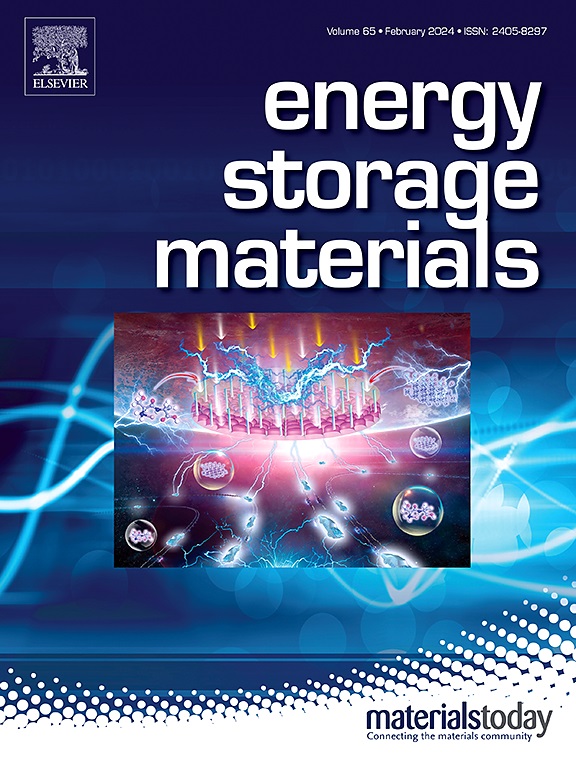宽温度范围内稳定锂金属电池用含cof限制溶剂离子液体的准固态电解质研究进展
IF 20.2
1区 材料科学
Q1 CHEMISTRY, PHYSICAL
引用次数: 0
摘要
对于安全和高能量密度锂金属电池(lmb)的发展来说,寻求既具有高离子电导率又具有热稳定性的固态电解质(sse)是必不可少的,这一目标提出了相当大的困难。在此,我们提出了一种创新的方法,通过将溶剂离子液体(SILs)限制在甲氧基官能化共价有机框架(COF-OMe)的纳米通道内来制备高性能准固态电解质(qses)。该设计利用了COF有序纳米通道和SILs之间的协同相互作用,导致qss具有优异的Li+电导率(高达1.65 × 10−4 S cm−1.25°C)和优异的热稳定性(高达150 °C)。实验和理论计算表明,限制的SILs和甲氧基通过降低锂盐的解离能和创造离子迁移的有效途径来协同增强Li+的运输。这导致锂离子转移数显著增加(高达0.80),并有效抑制锂枝晶的生长。在分子水平上,这些相互作用增强了离子电导率、转移数和整体热稳定性。这些qse在Li|QSSE|LiFePO4电池中实现时,在广泛的温度范围(-10 °C至80 °C)内表现出卓越的可循环性和速率性能。这项工作不仅为设计先进的sbs提供了新的途径,而且突出了基于cof的材料在下一代固态lmb中的潜力。本文章由计算机程序翻译,如有差异,请以英文原文为准。

Advancing quasi-solid-state electrolytes with COF-confined solvate ionic liquids for stable lithium metal batteries over a wide temperature range
The quest for solid-state electrolytes (SSEs) that exhibit both elevated ionic conductivity and thermal stability is imperative for the progression of secure and high-energy-density lithium metal batteries (LMBs), a goal that presents considerable difficulties. Herein, we present an innovative approach to fabricate high-performance quasi-solid-state electrolytes (QSSEs) by confining solvate ionic liquids (SILs) within the nanochannels of a methoxy‑functionalized covalent organic framework (COF-OMe). This design leverages the synergistic interaction between the COF's ordered nanochannels and the SILs, resulting in QSSEs that exhibit exceptional Li+ conductivity (up to 1.65 × 10−4 S cm−1, 25 °C) and excellent thermal stability (up to 150 °C). Experimental and theoretical calculations reveal that the confined SILs and methoxy groups synergistically enhance Li+ transport by lowering the dissociation energy of lithium salts and creating efficient pathways for ion migration. This results in a significant increase in the Li+ transference number (up to 0.80) and effectively suppresses lithium dendrite growth. At the molecular level, these interactions enhance ionic conductivity, transference number, and overall thermal stability. These QSSEs show exceptional cyclability and rate performance across an extensive temperature range (–10 °C to 80 °C) when implemented in Li|QSSE|LiFePO4 batteries. This work not only provides a new avenue for designing advanced SSEs but also highlights the potential of COF-based materials in next-generation solid-state LMBs.
求助全文
通过发布文献求助,成功后即可免费获取论文全文。
去求助
来源期刊

Energy Storage Materials
Materials Science-General Materials Science
CiteScore
33.00
自引率
5.90%
发文量
652
审稿时长
27 days
期刊介绍:
Energy Storage Materials is a global interdisciplinary journal dedicated to sharing scientific and technological advancements in materials and devices for advanced energy storage and related energy conversion, such as in metal-O2 batteries. The journal features comprehensive research articles, including full papers and short communications, as well as authoritative feature articles and reviews by leading experts in the field.
Energy Storage Materials covers a wide range of topics, including the synthesis, fabrication, structure, properties, performance, and technological applications of energy storage materials. Additionally, the journal explores strategies, policies, and developments in the field of energy storage materials and devices for sustainable energy.
Published papers are selected based on their scientific and technological significance, their ability to provide valuable new knowledge, and their relevance to the international research community.
 求助内容:
求助内容: 应助结果提醒方式:
应助结果提醒方式:


